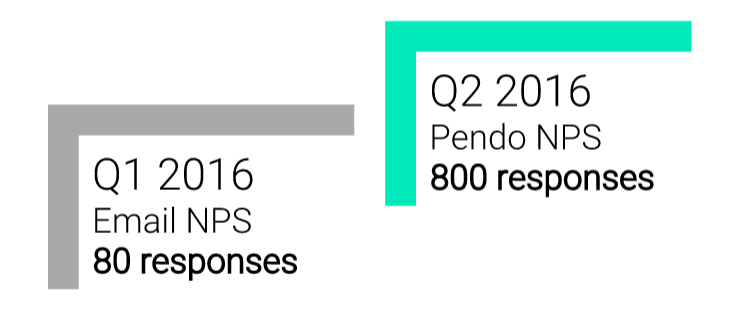This post was written by Dan Larsen, Senior Product Manager at Henry Schein.
As tech has taken a larger stake in our economy and the number of users of platforms has grown, the one-on-one relationship between business managers and customers has become impossible to maintain. Even managers of small and mid-size companies find it difficult to have a close relationship with every customer.
The shift of value delivered digitally means that fewer and fewer employee-to-customer interactions take place. With this shift, we risk losing the voice of the customer — because quite literally we don’t hear it the way we used to. The most successful tech platforms have exchanged one-on-one relationships with customers for deep and relevant data about the customer and an understanding of what they value based on their usage patterns.
NPS surveys are a simple and powerful way to understand customer loyalty.
Fred Reichheld, the author of The Ultimate Question, wrote that “Promoters” believe two things. First, that your product or service is of superior value. Second, that you value them (the customer) — head and heart. The mind of the customer believes what they’re getting is superior to other options on the market. Their heart says this company values me as a customer.
How does a tech company show they value their users when they have so many?
I’m a loyal customer of Apple. Their platform is undeniably great (my head believes it’s a “superior value”). However, I don’t know anyone at Apple personally. One way they prove that they value me is by giving me a great experience when I visit their stores. (My heart believes they value me as a customer.) The relatively few problems I’ve had with my iPhones in the past 10 years have all been resolved quickly and fairly. These two things — head and heart — make me a promoter of Apple.
Why should a tech company use NPS?
NPS is a great companion metric to sales, churn, and revenue. NPS can tell us things about our customers that other metrics do not. Without NPS, one dollar of revenue might look the same as another, but it isn’t. Only good profits, from happy customers, can be sustained long term. Bad profits come from “Detractors” which are unhappy customers. Simply put, Detractors are stuck in a bad relationship. So, why would they stick around if they’re unhappy? Maybe because they’re under a contract, they lack other options, the barriers to exit are too high, or they aren’t the buyer or decision maker. Once the balance of any of those things shifts that customer will leave, and without NPS, you might not see it coming.
Pendo is an incredibly powerful tool for gathering NPS scores and feedback. If you’re a Pendo user, but not yet running your NPS program through Pendo, get started. If another team in your company is running NPS through a different tool, ask them what they’re using to gather scores, and what kind of data they have on the respondents — such as user role, subscription level, purchase date, renewal date, geographic location, account size, monthly recurring revenue for the account, and key feature utilization.
Chances are, they don’t have much of this data, and the sample size of the respondents is probably low — which means the score is suspect, and it’s likely costing your company a good amount of money to gather. Your team will be happy to hear you care and have a better option.
Prior to using Pendo for NPS, our team distributed an email with a link to a popular survey tool. We asked each respondent a bunch of additional questions, which we already knew the answer to, but couldn’t correlate to NPS data because it was in a separate database. The result was that we received very few responses from a small sample size, which resulted in data that wasn’t actionable.
Once we began utilizing Pendo to gather NPS we immediately saw a 10x increase in survey responses.
I believe this happened for two reasons. First, because it was offered in-app, it was very easy for the user to respond. Second, because we only asked two questions — 1. How likely are you to recommend us to a friend or colleague? and 2. What is the main reason for your score —we didn’t need to ask other questions because additional data was available to us in Pendo. Additionally, Pendo automatically calculates your NPS score and the confidence interval based on your population of users and how many responses are received. The confidence interval tells you, for example, that your NPS score is 55 (+/- 5 points). This means that it could be as high as 60 or as low as 50.
This simple in-app NPS survey drastically increased our responses, giving us a much higher level of confidence that the results were truly reflective of customer sentiment, which in turn meant we had confidence in knowing where we needed to make improvements.
I recently shared my experience running our NPS program in a webinar with the Pendo team. You can check out the webinar here: Putting NPS to Work.






